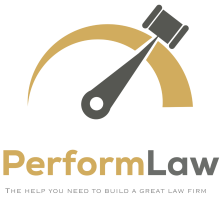This post continues our deep exploration of law firm compensation best practices. When setting base salaries, law firms should consider economic and qualitative performance expectations and comparative market salary data (when reliable and available). Combining these internal and external elements into an associate pay scale model that spans ten years will ensure the firm’s associate pay remains competitive and economically sustainable.
Determining a Target Base Salary Progression
Communicating how meeting performance expectations will impact an attorney’s pay is essential. Again, we recommend building this out considering the following factors for the first ten years of experience:
- Utilize the most accurate available data to determine the market pay rate for associates for each year of experience.
- Plug a draft salary progression into your associate compensation model using a first-year baseline, including profitability (Cash and Billed). We suggest an annual compensation escalator of the CPI plus appropriate market adjustments and merit. The market adjustment may indirectly account for merit, so keep that in mind.
- Set objective and subjective benchmarks.
- Ensure your model includes target working attorney billings and collections, considering rates and realization at various experience levels.
- Identify target profitability at each level.
- Compare the remainder to the projected overhead per lawyer at each level.
- Compare the remaining amount to cover overhead with each level's projected overhead per lawyer.
- Evaluate if the associate pay scale is both competitive and economically viable.
- Adjust the various factors, such as hours, rates, realization, and overhead costs, as needed.
Once the target salary progression model is satisfactory, firms can define a minimum/maximum salary range for years 1-10. Set salaries between the minimum and maximum for each experience year so higher raises and salaries can go to top performers without busting the salary scale.
Contribution Expectations Over Ten Years
Outlined below are the expected billable hours, billing rates, total billings, collection rates, and collections from Year 1 to Year 10, along with managed billings for other attorneys and paralegals. The progression of overhead, salaries, bonuses, total compensation, benefits, profit, and margin over the same period provides a clear economic model for planning and analysis.
| Contribution Expectations | Year 1 | Year 2 | Year 3 | Year 4 | Year 5 | Year 6 | Year 7 | Year 8 | Year 9 | Year 10 |
| Billable Hours | 1600 | 1650 | 1700 | 1700 | 1700 | 1700 | 1700 | 1700 | 1650 | 1650 |
| Billed Rate | $188 | $212 | $235 | $265 | $265 | $265 | $265 | $279 | $288 | $288 |
| Billings | $300,000 | $350,000 | $400,000 | $450,000 | $450,000 | $450,000 | $450,000 | $475,000 | $475,000 | $475,000 |
| Collected Rate | $156 | $182 | $206 | $235 | $241 | $247 | $253 | $265 | $273 | $273 |
| Collections | $250,000 | $300,000 | $350,000 | $400,000 | $410,000 | $420,000 | $430,000 | $450,000 | $450,000 | $450,000 |
| Target Profitability | 25% | 33% | 33% | 33% | 33% | 33% | 33% | 30% | 20% | 20% |
| Billings Managed (Other Attorneys/ Paralegals) | $0.00 | $0.00 | $0.00 | $0.00 | $0.00 | $0.00 | $0.00 | $100,000 | $150,000 | $200,000 |
| Economic Model Example | Year 1 | Year 2 | Year 3 | Year 4 | Year 5 | Year 6 | Year 7 | Year 8 | Year 9 | Year 10 |
| Collections | $250,000 | $300,000 | $350,000 | $400,000 | $410,000 | $420,000 | $430,000 | $450,000 | $450,000 | $450,000 |
| Overhead | $75,000 | $75,000 | $75,000 | $100,000 | $100,000 | $100,000 | $100,000 | $125,000 | $125,000 | $125,000 |
| Salary | $90,000 | $100,000 | $110,000 | $120,000 | $130,000 | $140,000 | $150,000 | $160,000 | $170,000 | $180,000 |
| Bonus | $5,000 | $6,000 | $7,000 | $8,000 | $10,000 | $10,000 | $10,000 | $12,000 | $15,000 | $18,000 |
| Total Comp | $95,000 | $106,000 | $117,000 | $128,000 | $140,000 | $150,000 | $160,000 | $172,000 | $185,000 | $198,000 |
| Benefits | $13,500 | $15,000 | $16,500 | $18,000 | $19,500 | $21,000 | $22,500 | $24,000 | $25,500 | $27,000 |
| Profit | $66,500 | $104,000 | $141,500 | $154,000 | $150,500 | $149,000 | $147,500 | $129,000 | $114,500 | $100,000 |
| Margin | 26.60% | 34.67% | 40.43% | 38.50% | 36.71% | 35.48% | 34.30% | 28.67% | 25.44% | 22.22% |
| Salary Raise % | 11.11% | 10.00% | 9.09% | 8.33% | 7.69% | 7.14% | 6.67% | 6.25% | 5.88% |
Overhead Policies
To develop an effective 10-year associate pay scale model, it is crucial to integrate a nuanced approach to profitability calculation that includes the allocation of overhead costs. A graduated method of allocating overhead is highly recommended.
This method allows junior attorneys to incrementally adapt to the firm's financial expectations by adjusting their overhead costs in alignment with their increasing billing and realization rates over time.
Junior associates generally have limited control over significant portions of the firm's overhead, such as office rent, administrative services, and technology costs. They primarily influence direct costs associated with their work, like legal assistant support. Therefore, it is essential for firm management and partners to oversee and optimize overhead cost management to maintain profitability.
Here is a sample of a progressive overhead allocation structure we use.
Allocated Overhead Conventions
| Timekeeper Type | Experience Level | Indirect Overhead Allocation Share |
| Equity Member/Partner | All | Full Share |
| Income Partner | All | 100% of an equity member’s share |
| Senior Counsel | All | 100% of an equity member’s share* |
| Senior Associate | All | 65% of an equity member’s share |
| Associate | 1-5 years | 50% of an equity member’s share |
| Paralegal | All | 25% of an equity member’s share |
Breakdown of Overhead Costs in Law Firm Management
Overhead costs in law firms are categorized into two types: directly allocated costs and generally allocated costs. These categories are crucial for setting equitable and effective financial strategies within the firm.
Direct Overhead Costs
Direct overhead costs primarily include legal assistant (secretarial) payroll and benefits. Directly allocating legal assistant (secretarial) costs to each lawyer incents sharing and introduces a measure of accountability into legal assistant (secretarial) use. Efficient use of these resources not only fosters sharing among attorneys but also enhances the firm's profitability, impacting bonus structures positively. Conversely, inefficient use can lead to higher direct overhead allocations for those attorneys, reducing their potential bonuses and overall profitability contribution.
Additionally, direct overhead may cover other clerical and support resource costs, directly tying resource usage to individual attorney performance and accountability.
Generally Allocated Overhead Costs
General overhead encompasses the remaining expenses not directly assigned to individual timekeepers.Law firms typically group expenses into the following areas:
- Salaries and Benefits
- Rent and Office Expenses
- Equipment and Practice Aids
- Practice Development
- General and Administrative.
While a detailed discussion of each category is extensive, it's essential to understand that these generally allocated overhead costs cover broad operational aspects of the firm and are crucial for its day-to-day functioning.
Discretionary Overhead Exclusions
Management discretion plays a significant role in overhead allocation, with the ability to exclude extraordinary expenses that might disproportionately affect the firm's profitability calculations. Such exclusions ensure that overhead allocations are fair and reflect the actual working conditions, including full-time equivalency and any adjustments for approved leave or partial-year performance of each attorney.
Effectively integrating these overhead considerations is pivotal for supporting the firm's strategic financial planning. Aligning overhead management with compensation goals ensures that the firm can maintain competitive pay structures while safeguarding its financial health and sustainability. This approach not only optimizes cost management but also reinforces the firm’s commitment to fair and strategic compensation planning over the long term.




 />i
/>i

